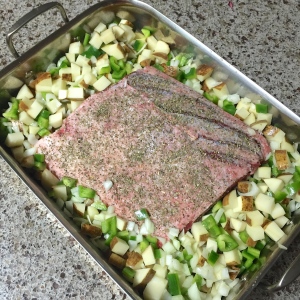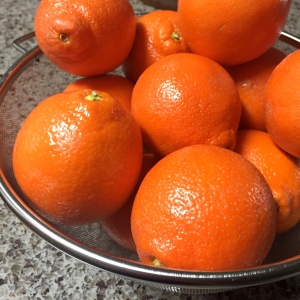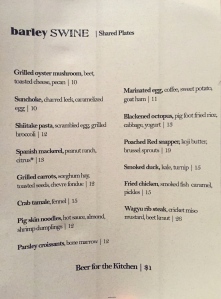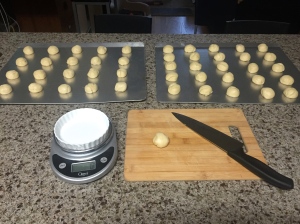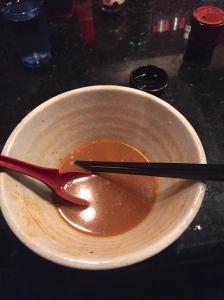A while back, Andrew and I were planning dinner. There was some chicken breasts in the freezer. Protein, check. But what to make with it? Wanting to utilize ingredients I already had, I took stock of the fridge and saw that I had half a head of cabbage, capers, thyme, shallots, and some preserved lemons, not to mention a bunch of vinegars in the pantry. So I thought, why not make some kind of cabbage slaw with a lemon-caper vinaigrette and place it on top of some mixed greens? It would be a nice, simple salad to pair with the poultry.
Andrew was skeptical of this idea. He loves cabbage, but the idea of it being practically the only thing in the salad wasn’t appealing to him. I understood. Raw cabbage can be tough and a little bitter. To counteract that, I finely shredded the cabbage using a mandoline. I wanted the cabbage to be really fine so that the cabbage would absorb the dressing better, softening its toughness and reducing its bitterness, yet still retain a pleasant crunch.
I expected the slaw to be good, but I wasn’t expecting Andrew’s reaction. He loved it. He said it was so good I should bottle the dressing and sell it. While I’ll leave the salad dressing business to Paul Newman, it was one of the best compliments on my cooking Andrew has given me. Perhaps his low expectations contributed to the inflated praise, but I’ll take it! As you can see, the slaw doesn’t look like much, but it packs a surprising amount of flavor. The preserved lemon is what really makes this recipe pop. It brightens the dish with splashes of lovely Meyer lemon without overpowering everything else.

I’ve made this slaw using a mix of green and purple cabbage as well. It tastes the same, but turns everything pink. It just depends on what aesthetic you’re going for. Add lentils (I like the little black kind with this) to make a more substantial lunch salad during the week. Because cabbage is so hearty, this keeps well in the fridge for a couple of days without turning soggy. I like to make large batches to have ready-made salads for dinner and/or lunch for a few days. Recipe is below!
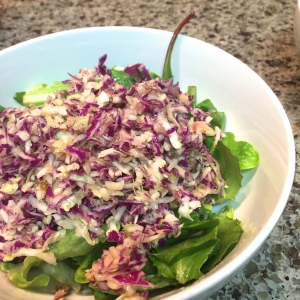
CABBAGE SLAW
This recipe is easily scalable for larger batches. The dressing is forgiving so the measurements below are really just a guide. I mostly make this to taste myself. I also realize that preserved lemons are not exactly a pantry staple, so if you don’t have any I’d use lemon zest and a bit of salt as a substitute. Maybe a little lemon juice as well, but then I’d reduce the amount of vinegar or it will become too acidic. I haven’t tried this substitution myself, but I’m sure it would work well enough. You won’t get those bites of salty Meyer lemony goodness, but you’d still get a nice lemon flavor which really livens the dressing.
INGREDIENTS (makes about 2-3 servings)
- Quarter head of cabbage
- Mixed greens
- 1/4 cup olive oil
- 2 tbsp champagne vinegar
- 1 small shallot, finely diced
- 1 clove garlic, minced and smashed or pressed through a garlic press
- 1 tbsp capers, roughly chopped
- 1/4 of preserved lemon, flesh removed, rind rinsed and minced.
- Fresh thyme to taste (if you have on hand. Dried works too, just use less)
- Pepper to taste
METHOD
- Set the cabbage and mixed greens aside.
- In a small bowl, whisk the remaining ingredients together until emulsified. Add more oil, vinegar, pepper, and/or thyme to taste. Let sit for an hour or so (if you have time) to let the flavors meld. Taste again and adjust any ingredients as needed.
- Meanwhile, finely shred the cabbage. I prefer to use a mandoline, but a food processor will work, too. You could, of course, slice it by hand, but I can never get it as thin as I want when I use a mandolin.*
- Mix dressing with cabbage. You can let it sit for 10-15 minutes to let it marinate or use right away.
- Lightly dress mixed greens with olive oil and champagne vinegar. Top with dressed cabbage and serve.
*If you like thin veggies for anything, you should totally get a mandoline. It’s a cooking game-changer. I got a PL8 Professional Mandoline and I love it. There are multiple cut settings, it’s easy to clean, and there’s many safety precautions so sliced fingers can easily be avoided. 🙂
